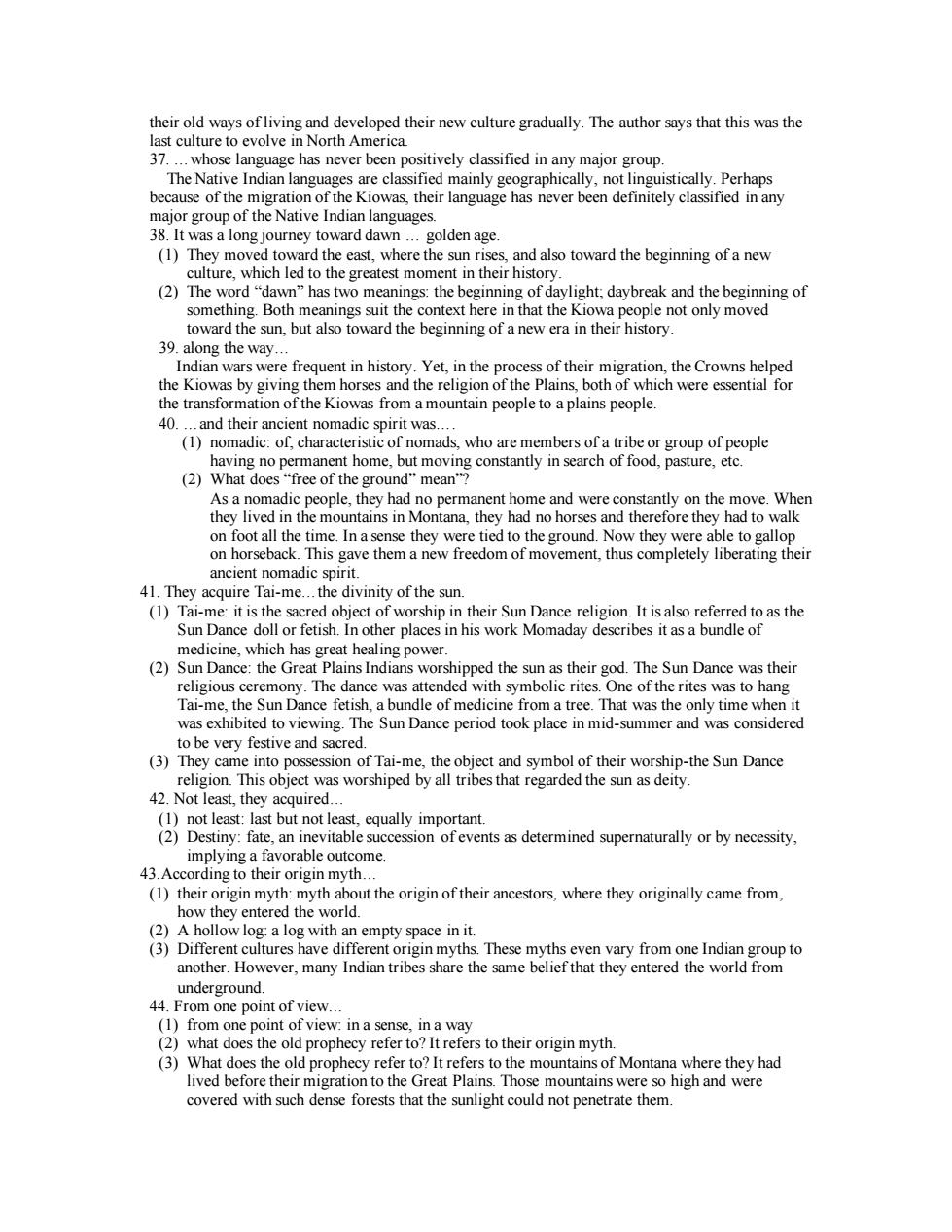正在加载图片...

their old ways ofliving and developed their new cuture gradually.The author says that this was the 32cu e to evolven The Native Indian langu ohedangua s never ben definitely clasified in ay languages s a I lden age (1)Th and also toward the beginning of a new culture.which led to theg reatest moment in their histor (2)The word"dawn"has two meanings:the beginning of daylight,daybreak and the beginning of ing.Both me ings suit th context her in that the Kiow sun,b l 39 alon Indian wars were frequent in history.Yet,in the process of their migration,the Crowns helped eRbSmdheeeomrhePnsoh hich were essential for m a mountain people to a plains people and the spir having no permanent home,but moving constantly in (2)What does free of the ground"mean" dic people,they no permanent home and were constantly on the th d.Nnd on horseback.This gave them a new freedom of movement.thus completely liberating their ancient nomadic spirit 41 -me. ivinity of th e sun n Da the heir Mo nce rel 10 medicine.which has great healing (2)Sun Dance:the Great Plains Indians wors ipped the sun as their god.The Sun Dance was their .h ith symbolic rites ne of t rites was o hang wd. to be very festive and sacred. (3)They 42.Neligon. Tai-me,the object and symbol of their worship-the Sun Dance as worshiped by all tril s that regarded the sun as delt iavftennevuablealcesonotevenssdeterminedsupermaturalW favorable outcome. ding t ut the origin of their ancestors,where they originally came from. orld (2)A hollow log:a log with an empty space in it. (3)Diffe These myths sme blief that they th even vary from one India 44.Fund nt of vieu (1)from one point of view:in a sense.in a way e old prophecy refer to?It refers to their origin myth. old prophecy reter to?Itr sto the re ere they had covered with such dense forests that the sunlight could not penetrate themtheir old ways of living and developed their new culture gradually. The author says that this was the last culture to evolve in North America. 37. .whose language has never been positively classified in any major group. The Native Indian languages are classified mainly geographically, not linguistically. Perhaps because of the migration of the Kiowas, their language has never been definitely classified in any major group of the Native Indian languages. 38. It was a long journey toward dawn . golden age. (1) They moved toward the east, where the sun rises, and also toward the beginning of a new culture, which led to the greatest moment in their history. (2) The word “dawn” has two meanings: the beginning of daylight; daybreak and the beginning of something. Both meanings suit the context here in that the Kiowa people not only moved toward the sun, but also toward the beginning of a new era in their history. 39. along the way. Indian wars were frequent in history. Yet, in the process of their migration, the Crowns helped the Kiowas by giving them horses and the religion of the Plains, both of which were essential for the transformation of the Kiowas from a mountain people to a plains people. 40. .and their ancient nomadic spirit was. (1) nomadic: of, characteristic of nomads, who are members of a tribe or group of people having no permanent home, but moving constantly in search of food, pasture, etc. (2) What does “free of the ground” mean”? As a nomadic people, they had no permanent home and were constantly on the move. When they lived in the mountains in Montana, they had no horses and therefore they had to walk on foot all the time. In a sense they were tied to the ground. Now they were able to gallop on horseback. This gave them a new freedom of movement, thus completely liberating their ancient nomadic spirit. 41. They acquire Tai-me.the divinity of the sun. (1) Tai-me: it is the sacred object of worship in their Sun Dance religion. It is also referred to as the Sun Dance doll or fetish. In other places in his work Momaday describes it as a bundle of medicine, which has great healing power. (2) Sun Dance: the Great Plains Indians worshipped the sun as their god. The Sun Dance was their religious ceremony. The dance was attended with symbolic rites. One of the rites was to hang Tai-me, the Sun Dance fetish, a bundle of medicine from a tree. That was the only time when it was exhibited to viewing. The Sun Dance period took place in mid-summer and was considered to be very festive and sacred. (3) They came into possession of Tai-me, the object and symbol of their worship-the Sun Dance religion. This object was worshiped by all tribes that regarded the sun as deity. 42. Not least, they acquired. (1) not least: last but not least, equally important. (2) Destiny: fate, an inevitable succession of events as determined supernaturally or by necessity, implying a favorable outcome. 43.According to their origin myth. (1) their origin myth: myth about the origin of their ancestors, where they originally came from, how they entered the world. (2) A hollow log: a log with an empty space in it. (3) Different cultures have different origin myths. These myths even vary from one Indian group to another. However, many Indian tribes share the same belief that they entered the world from underground. 44. From one point of view. (1) from one point of view: in a sense, in a way (2) what does the old prophecy refer to? It refers to their origin myth. (3) What does the old prophecy refer to? It refers to the mountains of Montana where they had lived before their migration to the Great Plains. Those mountains were so high and were covered with such dense forests that the sunlight could not penetrate them